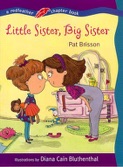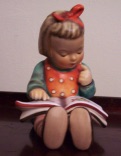Ideas for using
LITTLE SISTER, BIG SISTER
in the classroom
In four easy-to-read stories, Edna and Hester capture the essence of sisterhood as they boss each other around, stick up for each other at the pool, share candy, and make Thunder Cookies together.
"Brisson deftly captures the nuances of the dynamics of older/younger sibling interactions…Brief sentences and realistic scenarios offer emerging readers an opportunity to reach beyond picture books for further develop their skills." Kirkus Reviews
In the title of the story, Little Sister comes first because the author wants the reader to identify with, or see the stories from, the little sister's point of view. Discuss with your students whether it's better to be an older or younger sibling. Do parents treat siblings differently? Is this fair? Have them give examples from their lives. Have your students write ten "Rules for Parents" on how they will treat their children when they are parents.
Diana Cain Bluthenthal put a lot of detail in the illustration on page four. If possible, make an overhead transparency to project the image on a screen or wall. Allow students to study the picture for one or two minutes, then try to list as many items as possible from memory.
The idea for "Queen" came from a game the author's oldest sister made up in which she was the queen and her siblings had to wash the dishes and bring them to her for inspection. Have your students made up games or rituals in their own families? Can you give examples from your family? Share your stories with each other.
Discuss Hester's messy room in "Queen" and what Edna did to get it back into shape. Do your students prefer to have neat or messy rooms? Divide the class into groups. Each group should make a list with six or more reasons why it's better to have a neat or messy room. Let the groups compare results.
Time in a story can mean several different things. It can refer to time of day, time of the year or historical period. Have your students determine the three "times" of LITTLE SISTER, BIG SISTER and support their decisions from the text or illustrations. Help them discover that the stories happen in chronological order in the space of a single day.
Can they give examples of stories set in other historical periods?
Read the dedication by the author and illustrator. Why do your students think they chose those particular people to dedicate the book to? If your students had written these stories, to whom would they have dedicated the book?
In "Mermaids," Hester is bothered by two big kids who take her swim mask and won't give it back to her. Have your students write about a time older kids were mean to them or took advantage of them. How did this make them feel? Let them share their stories with each other.
In "The Chocolate Bar" Edna teases her older sister by describing how wonderful her Chompers Chewy Chocolate Bar is. How does she describe it? Help your students realize she is describing it by her sensations. Which of the five senses is not included? Why not? How does Edna play on the word "feel" at the end of the story?
Have your students vote on which story in LITTLE SISTER, BIG SISTER is their favorite. How many ways can they find to present the class results graphically (bar, pie, line, etc.)?
Send copies of the Thunder Cookies recipe home with your students so they can try it with a parent. Ask parents to send in one special recipe that is a family favorite. Compile a class cookbook with illustrations by your students to give to parents for a holiday gift.

